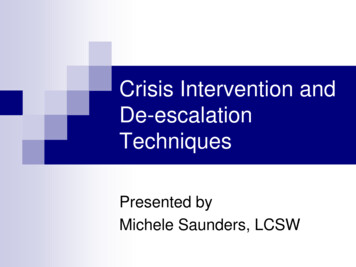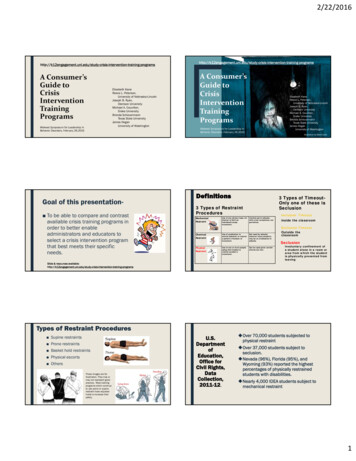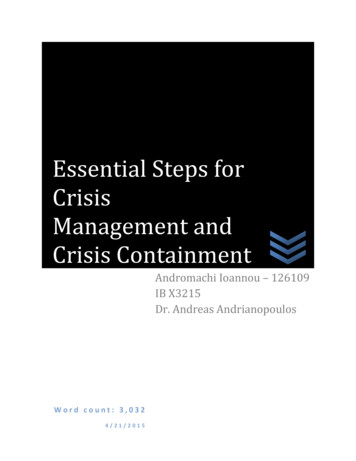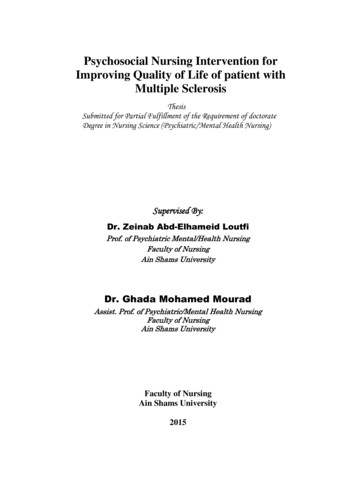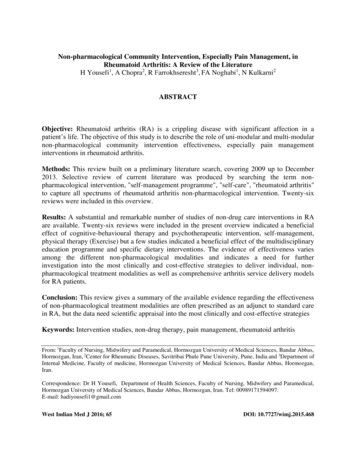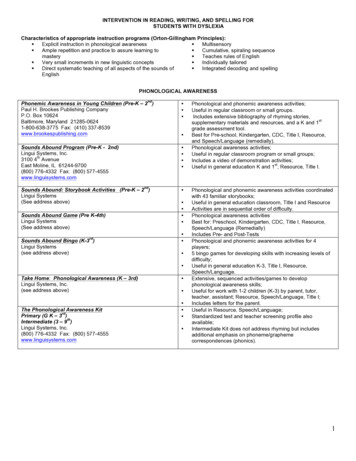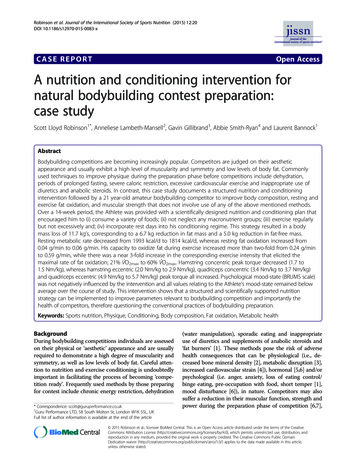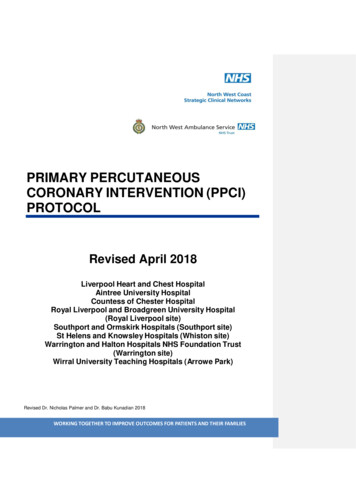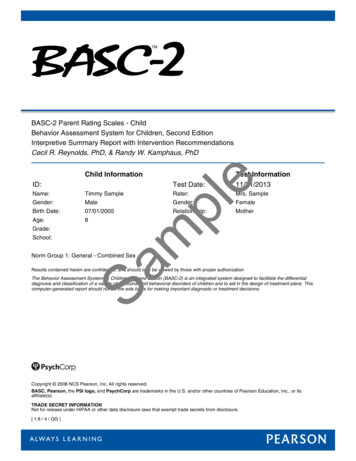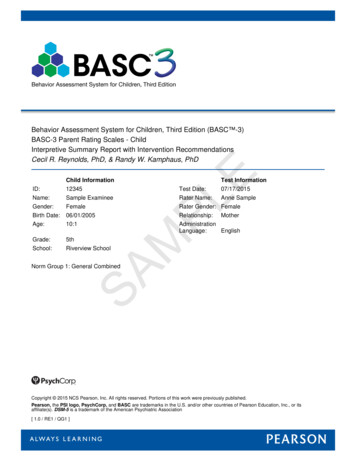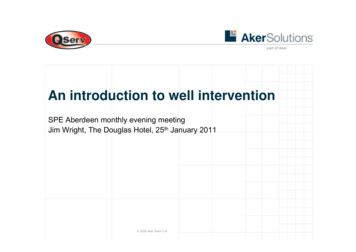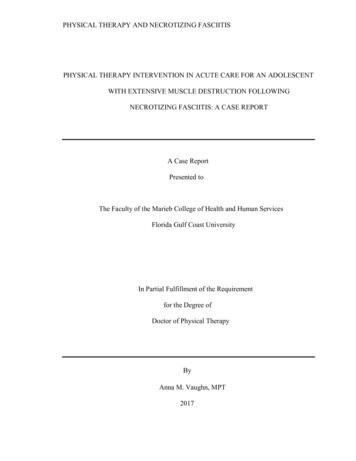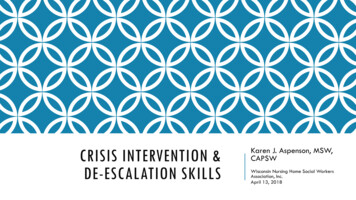
Transcription
CRISIS INTERVENTION &DE-ESCALATION SKILLSKaren J. Aspenson, MSW,CAPSWWisconsin Nursing Home Social WorkersAssociation, Inc.April 13, 2018
LEARNING OBJECTIVESIncrease awareness of verbal and nonverbal cues thatpotentially lead to crisis escalationIncrease awareness of the role of our sympathetic nervoussystem in how we respond to escalating situationsImprove existing and build new communication skills andtechniques while responding to an individual experiencingemotional crisis
Practice ways in which working as a team can prevent crisisescalationIdentify ways in which attendees may incorporate methods ofcrisis prevention and de-escalation in professional practiceSAFETY IS YOUR #1 PRIORITY – YOUCANNOT EFFECTIVELY INTERVENE IN A CRISISSITUATION IF YOU ARE NOT SAFE
WHO IS HERE TODAY?NameEmployerPositionPopulation(s) servedPrevious crisis intervention training?
WHAT IS A CRISIS?Not one universal definition What is your PROFESSIONAL definition of crisis? What is your PERSONAL definition of crisis?
ULTIMATELY, THERE ARE MANY DIFFERENTDEFINITIONS OF CRISIS EXPERIENCE LET’SEXAMINE THEM IN MORE DETAIL
People are in a state of crisis when they face an obstacle toimportant life goals For a time, this obstacle appears insurmountable by the use of customarymethods of problem solving A period of disorganization ensues during which many attempts atsolution are madeCrisis Intervention Strategies (7th ed.),Richard K. James & Burl E. Gillaland, 2013
Crisis results from impediments to life goals that peoplebelieve they cannot overcome through customarychoices and behaviorsCrisis Intervention Strategies (7th ed.),Richard K. James & Burl E. Gillaland, 2013
Crisis is a crisis because the individual knows no response todeal with a situationCrisis Intervention Strategies (7th ed.),Richard K. James & Burl E. Gillaland, 2013
Crisis is a personal difficulty or situation that immobilizespeople and prevents them from consciously controlling theirlives Does any one of these definitions ring true to you? How about parts of several different ones?Crisis Intervention Strategies (7th ed.),Richard K. James & Burl E. Gillaland, 2013
AN ADDITIONAL CONSIDERATION TRAUMA INFORMED CARE
Trauma Informed Care Prevalence of trauma experience (ACE Study) [Adverse Childhood Experiences] 58% report at least one traumatic event90% of mental health consumers have experienced traumaScientific evidence and cultural awarenessEvidence of effectiveness of trauma informed servicesTrauma informed care provides hope and emphasis on recovery
What is trauma?Trauma refers to extreme stress (e.g., threat to life, bodilyintegrity or sanity) that overwhelms a person’s ability to cope.The individual’s subjective experience determines whether ornot an event is traumatic.Traumatic events result in a feeling of vulnerability,helplessness and fearfulness.Traumatic events often interfere with relationships andfundamental beliefs about oneself, others and one’s place inthe world.(Giller, 1999; Herman, 1992)
Trauma Comes in Many Forms Abuse or Assault (sexual, physical,emotional, psychological)NeglectDomestic violenceWitnessed violenceDeprivation due to extreme povertyRepeated abandonment or sudden lossNatural disastersTraumatic brain injuriesWar experiencesMilitary sexual trauma (50% of women inthe military some sources cite higher %)
Sanctuary TraumaThe overt and covert traumaticevents that occur in varioussettings such as: mental health/substance abuse servicesmedicaleducationalreligiousworkplaceThese events are distressing,frightening, or humiliating
Immediate ImpactFight / Flight / Freeze Fight: resist Flight: run away Freeze: stay still
Simple TraumaSeeing, feeling, hearing, smelling something that reminds us of past traumaActivates the alarm systemThe response is as if there is current dangerThinking brain automatically shuts offPast and present danger become confusedComplex TraumaAll of the aboveMore reminders of past dangerBrain is more sensitive to dangerInteractions with others often serve as triggers
Acting Out vs. Acting In External defense Anger Violence towardsothers Truancy Criminal acts Internal defense Denial, repression Substance use Eating Disorders Violence to self Dissociation
Impact of Trauma on World View The world is an unsafe place to live in Other people are unsafe and cannot be trusted My own thoughts and feelings are unsafe I expect crisis, danger and loss I have no self-worth and no abilities How will this world view impact your ability to connect andengage with an individual in crisis?
Re-Experiencing Symptoms Experience the same mental, physical or emotionalexperiences of the trauma Flashbacks Trauma survivors can be triggered to the trauma bysights, sounds, smells or feelings
CRISISCrisis is a state of disorganization in which people face frustration ofimportant life goals or profound disruption of their life cycles andmethods of coping with stressors The term “crisis” usually refers to a person’s feelings of fear, shock, anddistress about the disruption, not to the disruption itselfCrisis Intervention Strategies (7th ed.),Richard K. James & Burl E. Gillaland, 2013
Crisis develops in four distinct stages:1. A critical situation occurs in which a determination is made as towhether a person’s normal coping mechanisms will suffice2. Increased tension and disorganization surrounding the eventescalates beyond the person’s coping ability3. A demand for additional resources to resolve the event is needed(counseling)4. Referral may be required to resolve major personalitydisorganizationCrisis Intervention Strategies (7th ed.),Richard K. James & Burl E. Gillaland, 2013
IN SUMMARYCrisis is a perception or experiencing of an event orsituation as an intolerable difficulty that exceeds theperson’s current resources and coping mechanisms Without relief, crises have the potential to cause severe affective,behavioral, and cognitive malfunctioningCrisis Intervention Strategies (7th ed.),Richard K. James & Burl E. Gillaland, 2013
CHARACTERISTICS OF CRISISYou may have seen the Chinese symbol for crisis It represents danger because it can overwhelm the individual to the extentthat serious pathology, including homicide and suicide, may result It represents opportunity because the pain it induces impels the person toseek help Does anyone have a story about a crisis that resulted in an opportunity?
THE WORLD’S ONLY MONUMENT TO AHORRIBLE DESTRUCTIVE PEST IS INENTERPRISE, ALABAMAhttps://www.google.com/search?q boll weevil monument&hl en&biw 1093&bih 498&prmd imvns&tbm isch&tbo u&source univ&sa X&ei gu9zTpfnBOiGsAKunt2LBQ&sqi 2&ved 0CCkQsAQ&gws rd ssl
IT’S COMPLICATEDCrisis is complex and difficult to understandDefies cause-and-effect descriptionCrisis workers find themselves intervening directly in avariety of areas, including in the community When large numbers of people are affected at the same time by a crisis,the entire ecological system of the environment may need intervention Hurricanes, floods, mass shootingsCrisis Intervention Strategies (7th ed.),Richard K. James & Burl E. Gillaland, 2013
Crisis causes disequilibrium Disequilibrium involves anxiety Anxiety results in discomfort Discomfort provides an opportunity for change. However, anxiety might need to reach a boiling point before the person may admitthe problem is out of controlCrisis Intervention Strategies (7th ed.),Richard K. James & Burl E. Gillaland, 2013
A counterintuitive point: Crisis results when a flashpoint is reached (quick) Quick fixes are rarely available Consider that many of the problems of persons in severe crisis stem from problemsthat have been around a long time. Perhaps a quick fix was attempted and it didn’twork it may have caused more harmCrisis Intervention Strategies (7th ed.),Richard K. James & Burl E. Gillaland, 2013
THE CHOICES WE MAKECan we agree that life itself is a series of challenges that weconfront or not In the realm of crisis, not to choose is a choice—usually a negative ordestructive one Choosing to do something contains the seeds of growth, allows anopportunity to set goals and formulate a plan to begin to overcome theproblemCrisis Intervention Strategies (7th ed.),Richard K. James & Burl E. Gillaland, 2013
Crisis is universal no one is immune, given the right set ofcircumstances What one person can overcome, another cannot Consider development of PTSD – we cannot say there is a cause-and-effectrelationship between the experience of trauma and the development of PTSD becausenot everyone who experiences trauma develops it
TRANSCRISIS STATESHow long does crisis last? Crises have typically been seen as time limited (maximum of 6-8weeks) Recent thinking is that the effects of the original crisis may extend a gooddeal beyond that time It may last a lifetimeCrisis Intervention Strategies (7th ed.),Richard K. James & Burl E. Gillaland, 2013
Even if a person believes that they have coped with a crisis event,it is possible that something may trigger the impact of the crisis toreoccur For example, if an adult who has unresolved anger toward a deceasedparent and transfers that anger, either consciously or unconsciously, toother authority figures, we consider them to be in a transcrisis stateCrisis Intervention Strategies (7th ed.),Richard K. James & Burl E. Gillaland, 2013
Transcrisis is not the same as PTSD PTSD is an identifiable anxiety disorder caused by an extremelytraumatic event and has specific criteria that must be present in order fora dx to be made While someone with PTSD may experience a transcrisis state, it can alsohappen to “normal people” The key differentiation of a transcrisis state is that no matter the cause,the state is residual and recurrent and always present to some degreeCrisis Intervention Strategies (7th ed.),Richard K. James & Burl E. Gillaland, 2013
People in a transcrisis state may be capable of functioning atsome minimal level, but they are always at risk of having asmall, added stressor send them into crisis For the psychology folks in the room what dx does this remind you of? And what is the best way to “control” that dx?Crisis Intervention Strategies (7th ed.),Richard K. James & Burl E. Gillaland, 2013
THEREFORE When we assess individuals in crisis, we need to focus not only onthe current clinical/diagnostic state of the individual, but also—and as importantly—on the repetitious cycle of problems and thehistorical precursors that may have caused (triggered) the crisis toarise Reinforces the need for trauma informed careCrisis Intervention Strategies (7th ed.),Richard K. James & Burl E. Gillaland, 2013
Awareness of transcrisis state can also offer importantinformation about the kind and degree of therapeuticintervention to provide What caused the event? How long has it been going on? What patterns can you find?Crisis Intervention Strategies (7th ed.),Richard K. James & Burl E. Gillaland, 2013
TRANSCRISIS POINTSTranscrisis points are benchmarks that are crucial to progressive states ofpositive therapeutic growthOften characterized by approach-avoidance behavior in regards toseeking help and making changesTranscrisis points create the same sense of disequilibrium as theexperience of crisisCrisis Intervention Strategies (7th ed.),Richard K. James & Burl E. Gillaland, 2013
Therefore, crisis workers must work with not onlythe original crisis, but with each transcrisis pointthat arises Workers can be shocked, confused, and overwhelmed by thesuddenness of which these transcrisis points can occurCrisis Intervention Strategies (7th ed.),Richard K. James & Burl E. Gillaland, 2013
ROLE OF THE PROFESSIONALTeach and model emotional regulation and de-escalationskillsThis requires that we understand what happens to US in acrisis situation
BREAK!Lunch
Crisis intervention models Equilibrium modelCognitive modelPsychosocial transition modelDevelopmental-Ecological modelContextual-Ecological model You have explanations of each in your handout
Eclectic crisis intervention theory Involves intentionally and systematically selecting andintegrating valid concepts and strategies from ALLavailable approaches Operates from a task orientation– Major tasks are:1. Identify valid elements in all systems and integrate them into aninternally consistent whole2. To consider all pertinent theories, methods, and standards forevaluating clinical data3. Identify with no specific theory, keep an open mind, and continuouslyexperiment with strategies that produce successful results
Using an eclectic approach means not being boundby and locked into any one theoretical approach Eclecticism performed well is equal parts skill andintuition– Must pay attention to feelings as much as to cognitionabout the situation
Characteristics ofeffective crisis workers It is necessary for crisis workers to have both technical skill andtheoretical knowledge, plus Life experiences Poise Creativity and flexibility Energy and resiliency Quick mental reflexes The ability to be nonjudgmental
LifeexperiencesSometimes people choose to engage in crisis intervention workbecause they have experienced the same kind of crises; they usetheir experiential background as a resource Consider working with Veterans who experience PTSD Doesa practitioner with personal experience as a veteran or with PTSDhave an edge? Yes. Develops Servesrapport quickeras a role model for recovery
Poise Mustremain calm, no matter what the worker isconfronted with Creatinga stable and predictable environmentprovides a model for the client that is conduciveto restoring equilibrium
Creativityand flexibility Majorassets when confronted with seeminglyunsolvable problems Dependsto a large measure on how well theworker has nurtured their own creativity over thecourse of their lives by taking risis and practicingdivergent thinking
Energyand resiliency Whileprofessional training can provideguidelines and principles for performance, itcannot provide the energy needed to performcrisis work Resiliency “bounce back” potential this istough work that is often not immediatelysuccessful What’sgoing to bring you back tomorrow?
Quickmental reflexes Timeis a critical factor in crisis work Littletime to reflect or mull over options Aworker who cannot think fast and accuratelywill find crisis work very frustrating
Nonjudgmental Itmay seem to you that the situationexperienced by an individual hardly reaches tothe level of crisis However,we must maintain the ability to suspendjudgment what the individual is experiencing isreal and true to them Remember we must not judge anyone’s pain as being more or lessthan someone else’s It is what it is
Plus Tenacity Abilityto delay gratification Courage Optimism Realityorientation Calmnessunder duress Objectivity Strong& positive self-concept Abidingfaith in human nature
Theideal crisis worker is one who hasexperienced life, has learned and grown fromthose experiences, and supports thoseexperiences in his/her work by thorough training,knowledge, and supervision
BREAK!10 minutes
CRISIS DE-ESCALATION SKILLSImpact of the Sympathetic Nervous System (SNS)Principles of crisis interactionCommunication do’s and don’t’s“Mike’s 10 Commandments of De-Escalation” Adapted from The Art of De-Escalation by Lt. Michael S. Woody (Ret), 2005
SYMPATHETIC NERVOUS SYSTEMUnder stress, the SNS will: Increase your heart rate Increase your motor control and physical strength Decrease your fine and complex motor skills The brain constricts our perception to the most dominant and mostreliable of our senses, our sight As we perceive an increased threat, our stress level increases,causing our own performance to decline Train to Win, Wes Doss, 2003
SNS tiveTrain to Win, Wes Doss, 2003
PRINCIPLES OF CRISIS INTERACTION1. Approach in a non-threatening manner2. Give the individual time to vent, explain, or complain, and give yourself time toassess3. Using calm tones, give supportive, confident, and empathic statements4. Establish trust and rapport; don’t rush the initial interaction
5. Be aware of the individuals’ and your own posture (non-verbal communication) atall times6. Refocus the person to the problem at hand7. Ask about medications and information about treating professionals8. Take a few minutes to re-establish rapport as needed9. Begin to give options and bring the interaction to a conclusionREMEMBER: YOUR GOAL IS TO HELP THE INDIVIDUAL RETURNTO THEIR PRE-CRISIS STATE
COMMUNICATION DO’S AND DON’T’S**Don’t deny the possibility of violence when early signs of agitation are noticed*** Don’t underestimate information provided by collateral sources* Don’t engage in behaviors that can be interpreted as aggressive* Don’t make promises you can’t keep* Don’t allow your own feelings of fear, anger, or hostility to interfere with self-controland a professional demeanor* Don’t argue, give orders, or disagree unless absolutely necessary* Don’t be placating by giving in and greeing to all the real and imagined ills of theperson
* Don’t become condescending by using cynical, sarcastic, or satirical remarks* Don’t let your own importance be acted out in a know-it-all manner* Don’t raise your voice, put on a sharp edge, or use threats to gain compliance* Don’t mumble, speak hesitantly, or use a tone so low that you cannot be understood* Don’t argue over small points – pick your battles!* Don’t attempt to reason with anyone under the influence of a mind-alteringsubstance* Don’t allow a crowd to congregate* Don’t corner or be cornered – give the person expanded space* Don’t ask “why?”* Don’t deny the opportunity for the person to “save face”* Don’t rush, be rushed, or lose your own cool
DE-ESCALATION TECHNIQUES Remain calm – you are a role modelIf you lose your cool, the situation will escalate Isolate the individual – crowds can become cheerleaders who escalate thecrisis responseYou will be more effective 1:1 Keep it simple – be clear and direct in your message
Watch your body language – be aware of your space, posture, and gesturesMake sure your nonverbal behavior is consistent with your verbal message Use silence – this is one of the most effective verbal intervention techniquesSilence on your part allows the individual to clarify and restate Use reflective questioning – paraphrase and restate commentsBy repeating or reflecting the person’s statement in the form of a question,you’ll help the individual gain insight Watch your paraverbal communication – any two identical statements can havecompletely opposite meanings, depending on how the tone, volume and cadenceof your voice are alteredMake sure the words you use are consistent with voice inflection to avoid adouble message
MIKE’S 10 COMMANDMENTS OF DE-ESCALATION1. Your safety comes first2. Keep therapeutic spacing3. Speak in tones that fit the situation4. Use non-threatening posture5. Personalize the conversation (use first names, with permission unless you know theindividual well)6. Ask how you can help7. Don’t be afraid to set firm yet calm limits8. Never validate hallucinations9. Don’t internalize negative comments10. Never forget that people may be dealing with trauma or disease that they didnothing to inherit
Compassion FatigueAdapted from a presentationBy Martha Teater, LFMT, LCAS, LPCJune 10, 2011
“The expectation that we can beimmersed in suffering and loss daily andnot be touched by it is as unrealistic asexpecting to be able to walk throughwater without getting wet.” Remen
What is compassion fatigue? Compassion Fatigue Compassion is
Crisis is a state of disorganization in which people face frustration of important life goals or profound disruption of their life cycles and methods of coping with stressors The term “crisis” usually refers to a person’s feelings of fear, shock, and di
